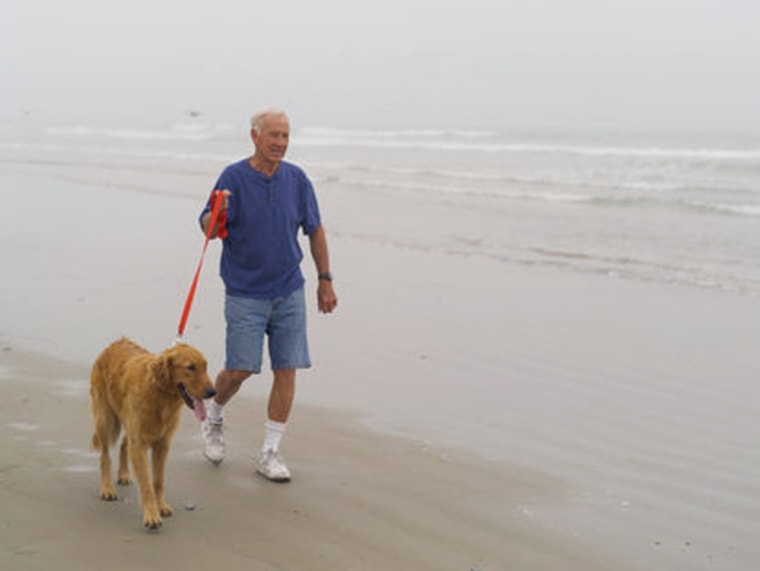Fitness can protect you from cancer -- even 20 or more years down the road, researchers report. And men who were the most fit in middle age were the least likely to die a quarter century later even if they were unlucky enough to get cancer, a new study finds.
Men who were the most fit at age 50 back in the 1970s were the least likely to develop lung or colon cancer 20 to 25 years later, the study, which will be presented next month at a meeting of the American Society of Clinical Oncology, or ASCO, found. And among the men who did get lung, colon or prostate cancer, the fitter they were in their early 50s, the less likely they were to die of it.
This is good news for people who want to lower their risk of not only heart disease but cancer, says Dr. Susan Lakoski of the University of Vermont, who led the study. She’s a cardiologist who studies fitness and its effect on disease.
“Two things you can’t change are your genes and your age,’ she said. “But you can get more fit.”
Lakoski studied data on more than 17,000 men who attended the Cooper Institute in Dallas. Dr. Kenneth Cooper, who coined the word “aerobics”, founded the research institute in 1970. The men all took fitness tests on their first visits to the institute, and the institute later acquired their medical records.
Their fitness was measured by metabolic equivalent of task, or MET.
“One MET is sitting on the couch,” Lakoski said.
On a treadmill test that involves making someone walk briskly on an incline, the average middle-aged person, she said, can get up to about 9 METs, while athletes can achieve up to 15 METs and elite triathletes can get to about 20 METs.
In this study, the least fit men were able to stay on the treadmill at full tilt for less than 13.5 minutes if they were 40 to 49 years old, less than 11 minutes if they were 50 to 59, and less than 7.5 minutes if they were 60 or older.
Over the next 20 to 25 years, 2,332 of the men were diagnosed with prostate cancer, 276 got colon cancer and 277 were diagnosed with lung cancer. And 347 of the men died of cancer while 159 died of heart disease.
Lakoski’s team divided the men into five groups based on their fitness at that first visit, when they were around 50 years old. Those who were the most fit were 68 percent less likely to develop lung cancer and 38 percent less likely to develop colon cancer 20 years later. And if the men did develop cancer, those who were the most fit were significantly less likely to die of any of the three cancers.
Every increase in fitness as measured by MET lowered the risk of dying from cancer by 14 percent and from heart disease by 23 percent, Lakoski found. And obesity had little or nothing to do with it, she found.
“This important study establishes cardiorespiratory fitness as an independent and strong predictor of cancer risk and prognosis in men,” ASCO president Dr. Sandra Swain said in a statement.
“While more research is needed to determine if similar trends are valid in relation to other cancers and among women, these results indicate that people can reduce their risk of cancer with relatively small lifestyle changes.”
Lakoski doesn’t know if it’s possible to be out of shape at 50 but then get into shape later and lower cancer risk. “Can you turn things around?" she asked. But people who were fit at 50 were likely lifelong exercisers. “People who enjoy being fit tend to stay fit,” she said.
Many studies have shown that exercise lowers the risk of cancer, but this one is one of the first to show it can also reduce the risk of dying from cancer. ASCO says more than 50 studies involving 40,000 people have found that people who exercise regularly have a 40 percent to 50 percent lower risk of colon cancer, for instance. And women who exercise at moderate-to-vigorous levels for more than three hours a week have a 30 percent to 40 percent lower risk of breast cancer.
It’s not likely that the fittest men were somehow just stronger and better able to survive disease, Lakoski and ASCO both say. Hormones such as prostaglandin and insulin likely play a role, as well as the immune system and a process called oxidation, which damages cells and DNA.
Lakoski argues people need to be told something a little more specific than simply to exercise. They need a precise fitness goal, and doctors need to help them measure it. Current guidelines are very imprecise, she noted.
“Tell someone to do 150 minutes of moderate exercise a week, is that right for you? Is that right for me?” Lakoski asked.
But there are precise measures. Lakoski uses one in her lab, where she is the director of Cardiovascular Prevention for Cancer Patients at the Vermont Cancer Center. She works patients to the point of exhaustion, and measures how long it takes to get there. “If I can put you on a treadmill and say ‘You went this many minutes and you burned this many METs and that is associated with X reduction in cancer risk and cardiovascular risk’, that’s very meaningful,” she said.
“Then I can say you need to do this much exercise training to get this fit. People can get their heads around it. It is a personalized prescription.”
Related:
